NEET Previous Year Questions (2014-2024): Reproductive Health | Biology Class 12 PDF Download
2024
Q1: Which of the following is not a natural/traditional contraceptive method? (NEET 2024)(a) Coitus interrupts
(b) Periodic abstinence
(c) Lactational amenorrhea
(d) Vaults
 View Answer
View AnswerAns: (d)
Vaults are not a natural or traditional contraceptive method. They refer to barrier methods such as cervical caps, which are modern contraceptive devices used to prevent sperm from entering the uterus, unlike natural methods like coitus interruptus, periodic abstinence, and lactational amenorrhea that rely on behavioral practices without the use of physical devices.
Q2: Match List I with List II (NEET 2024)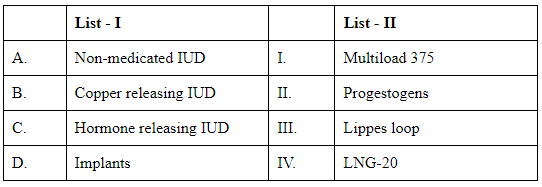
Choose the correct answer from the option given below:
(a) A-III, B-I, C-II, D-IV
(b) A-I, B-III, C-IV, D-II
(c) A-IV, B-I, C-II, D-III
(d) A-III, B-I, C-IV, D-II
 View Answer
View AnswerAns: (d)
Let's analyze each item in List-I and find the appropriate match from List-II:
Non-medicated IUD - This type of intrauterine device (IUD) does not contain any hormones or active pharmaceutical ingredients. It solely relies on the presence of a foreign body within the uterus to prevent pregnancy. A representative example of a non-medicated IUD is Lippes loop, which is an inert, flexible plastic loop. Therefore, A corresponds to III.
Copper releasing IUD - These IUDs release a small amount of copper into the uterus, which enhances contraceptive efficacy. Multiload 375 is a typical example of a copper-releasing IUD as it includes a copper component. Thus, B corresponds to I.
Hormone releasing IUD - These IUDs release a hormone to prevent pregnancy. One well-known hormone releasing IUD is LNG-20, also known as Mirena, which releases levonorgestrel, a type of progestogen, directly into the uterus. Consequently, C corresponds to IV.
Implants - These are typically small rods containing progestin that are implanted under the skin. Since the description coincides with the progestogens' action (such as Norplant), D corresponds to II.
Based on the analysis:
A corresponds to III (Lippes loop).
B corresponds to I (Multiload 375).
C corresponds to IV (LNG-20).
D corresponds to II (Progestogens).
Therefore, the correct matches for the options are: Option D: A-III, B-I, C-IV, D-II
2023
Q1: Given below are two statements: one is labelled as Assertion A and other is labelled as Reason R. [NEET 2023]
Assertion A : Amniocentesis for sex determination is one of the strategies of Reproductive and Child Health Care Programme.
Reason R : Ban on amniocentesis checks increasing menace of female foeticide.
In the light of the above statements, choose the correct answer from the options given below.
(a) Both A and R are true and R is the correct explanation of A.
(b) Both A and R are true and R is NOT the correct explanation of A.
(c) A is true but R is false.
(d) A is false but R is true.
 View Answer
View AnswerAns. (d)
- The correct answer is option (4) as ‘Reproductive and Child Health Care (RCH) programme’ deals with creating awareness among people about various reproduction related aspects and providing facilities and support for building up a reproductively healthy society.
- Amniocentesis is basically used to test for the presence of certain genetic disorders such as Down’s syndrome, haemophilia, etc., to determine the survivability of the foetus.
- Amniocentesis is not a sex determination technique in India and is not a strategy of RCH.
It was banned in India around 1994 under the Pre-Conception and Prenatal Diagnostic Techniques Act, which is an Act of the Parliament of India enacted to stop female foeticides and arrest the declining sex ratio in India.
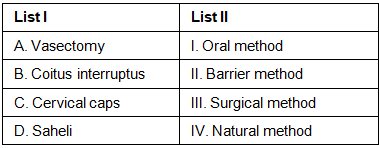
Choose the correct answer from the options given below:
2022
Q1: Which of the following is not an Intra Uterine Device?
(a) Progestasert
(b) B Progestogens
(c) Multiload 375
(d) Lippes loop [NEET 2022 Phase 2]
 View Answer
View AnswerAns: (b)
Option (b) is the correct answer as progestogens are the synthetic forms of progesterone.
Option (a) is not the answer as progestasert is an hormone releasing IUD.
Option (c) is not the answer as Multiload-375 is a copper releasing IUD.
Option (d) is not the answer as Lippes loop is an inert IUD.
Q2: IUDs are small objects made up of plastic or copper that are inserted in the uterine cavity. Which of the following statements are correct about IUDs ?
1. IUDs decrease phagocytosis of sperm within the uterus.
2. The released copper ions suppress the sperm motility.
3. IUDs do not make the cervix hostile to the sperm.
4. IUDs suppress the fertilization capacity of sperm.
5. The IUDs require surgical intervention for their insertion in the uterine cavity.
Choose the most appropriate answer from the options given below:
(a) (4) only
(b) (1), (4) and (5) only
(c) (2) and (3) only
(d) (2) and (4) only [NEET 2022 Phase 2]
 View Answer
View AnswerAns: (d)
Option (d) is the correct answer as only statements (b) and (d) are correct because the Cu ions which are released suppress the sperm motility and the fertilising capacity of sperms.
Option (a) is incorrect as statement (b) is also a correct statement.
Option (b) is incorrect as IUDs increase the phagocytosis of sperms and IUD's insertion does not require surgical intervention.
Option (c) is incorrect as hormonal IUDs suppress endometrial changes and changes in cervical mucus, thereby making the cervix hostile to the sperms.
Q3: Lippe's loop is a type of contraceptive used as: [NEET 2022]
(a) Vault barrier
(b) Non-Medicated IUD
(c) Copper releasing IUD
(d) Cervical barrier
 View Answer
View AnswerAns. (b)

- Lippe’s loop is an example of a non-medicated intrauterine device or IUD used in female contraception.
Lippes loop is a plastic double “S” loop.
It attracts the macrophages stimulating them to accumulate in the uterine cavity.
Macrophages increase phagocytosis of sperms within the uterus and act as a contraceptive.
Q4: Match List-I with List-II with respect to methods of Contraception and their respective actions. [NEET 2022]
Choose the correct answer from the options given below:
(A) (a) - (iv), (b) - (i), (c) - (ii), (d) - (iii)
(B) (a) - (ii), (b) - (iv), (c) - (i), (d) - (iii)
(C) (a) - (iii), (b) - (ii), (c) - (i), (d) - (iv)
(D) (a) - (iv), (b) - (i), (c) - (iii), (d) - (ii)
 View Answer
View AnswerAns. (a)
- Diaphragm are dome-shaped rubber plastic covers that have to be fitted on the cervix in the female's vagina to check the entry of sperms into the uterus.
- Oral pills are the hormonal tablets are taken orally. These pills contain a combination of synthetic hormones like progesterone and estrogen. These hormones inhibit ovulation and implantation by inhibiting the secretion of FSH and LH from the pituitary gland.
IUDs (Intrauterine Devices) are made of plastic, metal, or a combination of the two and are inserted into the uterus to prevent conception. IUDs increase phagocytosis of sperms within the uterus and the hormone releasing IUDs make the uterus unsuitable for implantation and the cervix hostile to the sperms.
Lactational Amenorrhea is also a natural method of birth control where there is no menstrual cycle and therefore ovulation does not occur during intense lactation following parturition.
2021
Q1: Which of the following is hormone-releasing IUD? [NEET 2021]
(a) LNG-20
(b) Multiload-375
(c) Lippes loop
(d) Cu-7
 View Answer
View AnswerAns. (a)
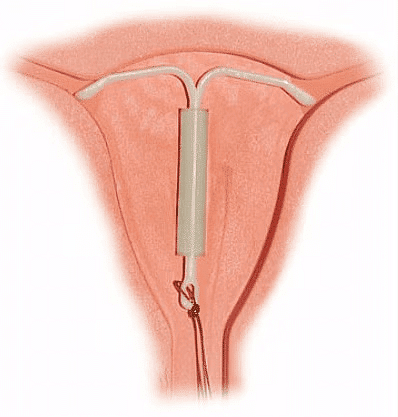 LNG 20
LNG 20
- Levonorgestrel hormone is released from LNG-20. It is highly effective for contraception. The risk of unwanted pregnancy is lower with LNG-20 because it causes endometrial atrophy and alter the stroma to inhibit the process of implantation.
- Lippes loop is an IUD impregnated with barium sulphate. IUDs like CuT and multiload-375 release copper that suppress the motility of sperm thus reducing its fertilising capacity. Thus, Lippes loop, CuT and multiload-375 are not hormone releasing IUDs.
Q2: Venereal diseases can spread through: [NEET 2021]
(i) Using sterile needles
(ii) Transfusion of blood from infected person
(iii) Infected mother to foetus
(iv) Kissing
(v) Inheritance
Choose the correct answer from the options given below.
(a) (ii) and (iii) only
(b) (i) and (iii) only
(c) (i), (ii) and (iii)
(d) (ii), (iii) and (iv)
 View Answer
View AnswerAns. (a)
- Venereal diseases or sexually transmitted diseases or infections are transmitted by sharing of infected needles, surgical instruments with infected person, transfusion of blood or from an infected mother to foetus.
- Venereal diseases are not transmitted through kissing or inheritance.
Q3: Match List-I with List-II [NEET 2021]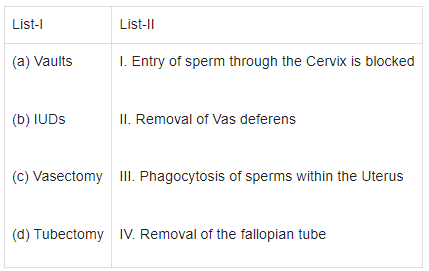 Choose the correct answer from the options given below.
Choose the correct answer from the options given below.
(a) (b) (c) (d)
(a) (ii) (iv) (iii) (i)
(b) (iii) (i) (iv) (ii)
(c) (iv) (ii) (i) (iii)
(d) (i) (iii) (ii) (iv)
 View Answer
View AnswerAns. (d)
- Vaults is a rubber dome, which fits over the vaginal vault or cervix. They prevents the entry of sperm into the uterus.
- IUDs are the devices which are inserted by the doctors or trained nurses into the uterus of female. These IUDs increase phagocytosis of sperm in uterus.
- Vasectomy : Surgical removal of the small part of vas deferens. It is a form of male birth control that inhibits to transport of male gamete.
- Tubectomy is a surgical method of contraception in females where a small part of the fallopian tube is removed or tied up through a small incision in the abdomen or through vagina.
 Vasectomy
Vasectomy
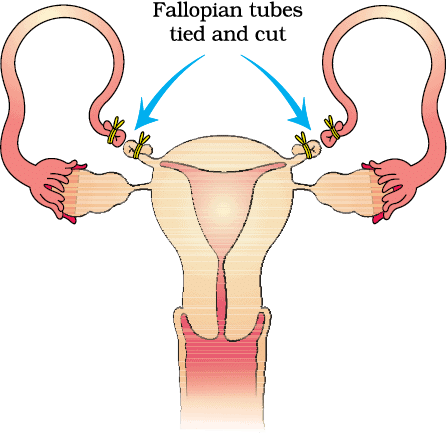 Tubectomy
Tubectomy
2020
Q1: In which of the following techniques, the embryos are transferred to assist those females who cannot conceive? [NEET 2020]
(a) ICSI and ZIFT
(b) GIFT and ICSI
(c) ZIFT and IUT
(d) GIFT and ZIFT
 View Answer
View AnswerAns. (c)
ART in which embryos are transferred, include ZIFT and IUT i.e. Zygote Intrafallopian Transfer and Intra Uterine Transfer respectively, both are embryo transfer (ET) methods.
 |
Test: Reproductive Problems and Strategies
|
Start Test |
2019
Q1: Which of the following contraceptive methods involve the role of hormones?
(a) Pill, Emergency contraception, Barrier methods
(b) Lactational amenorrhea, Pills, Emergency contraceptives
(c) Barrier method, Lactational amenorrhea pills
(d) Cut, Pills, Emergency contraceptive [NEET 2019]
 View Answer
View AnswerAns. (b)
Lactational amenorrhea is a period of intense lactation during which ovulation does not occur Pills and emergency contraceptives contain hormones.
Q2: Select the horomone-releasing Intra-Uterine Devices.
(a) Progestasert, LNG-20
(b) Lippes Loop, Multiload 375
(c) Vaults, LNG-20
(d) Multiload 375, Progestasert [NEET 2019]
 View Answer
View AnswerAns: (a)
Progestasert, and LNG-20 are hormone releasing IUDs, which makes the uterus unsuitable for implantation and the cervix hostile to the sperms.
2018
Q1: The contraceptive ‘Saheli’: [NEET 2018]
(a) Blocks estrogen receptors in the uterus, preventing eggs from getting implanted.
(b) Increases the concentration of estrogen and prevents oblation in females.
(c) Is an IUD
(d) Is a post-coital contraceptive.
 View Answer
View AnswerAns. (a)
Saheli is a mini pill that contains a nonsteroidal preparation called centchroman, which is taken once a week after an initial intake of twice a week for 3 months. It blocks estrogen receptors in the uterus hence alters uterine lining and prevents fertilized eggs from being implanted.
2017
Q1: Match the following sexually transmitted diseases (Column I) with their causative agents (Column II) and select the correct option. [NEET 2017]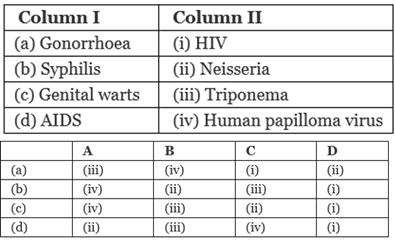
 View Answer
View AnswerAns. (d)
- Gonorrhoea is a sexually transmitted disease (STD) caused by infection with the Neisseria gonorrhoeae bacterium. N. gonorrhoeae infects the mucous membranes of the reproductive tract, including the cervix, uterus, and fallopian tubes in women, and the urethra in women and men.
- Syphilis is a chronic infectious disease caused by the spirochaete Treponema pallidum. Syphilis is usually transmitted by sexual contact or from mother to infant, although endemic syphilis is transmitted by non-sexual contact in communities living under poor hygiene conditions.
- Genital warts are caused by several of the epidermotropic human papillomaviruses (HPVs). HPV-6 and HPV-11 most commonly are isolated.
Acquired immunodeficiency syndrome (AIDS) is a chronic, potentially life-threatening condition caused by the human immunodeficiency virus (HIV).
Q2: The function of copper ions in copper releasing IUDs is:
(a) They inhibit gametogenesis
(b) They make the uterus unsuitable for implantation
(c) They inhibit ovulation
(d) They suppress sperm motility and fertilization capacity of sperm. [NEET 2017]
 View Answer
View AnswerAns. (d)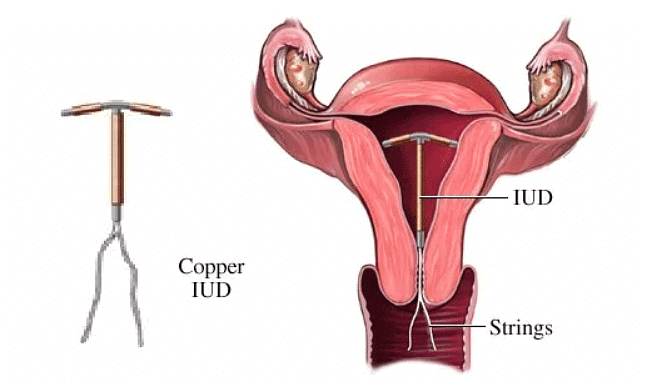
Cu2+ interfere in the sperm movement, which suppress the sperm motility and fertilising capacity of sperms.
2016
Q1: Which of the following is hormone releasing IUD ?
(a) Lippes loop
(b) LNG-20
(c) Cu7
(d) Multiload 375 [NEET 2016 Phase 2]
 View Answer
View AnswerAns: (b)
LNG-20 is the hormone releasing IUD, multiload 375 and Cu7 are copper releasing IUDs and Lippes loop is a non-medicated IUD.
Q2: Which of the following is incorrect regarding vasectomy?
(a) No sperm occurs in seminal fluid
(b) No sperm occurs in the epididymis
(c) Vasa deferentia is cut and tied
(d) Irreversible sterility [NEET 2016]
 View Answer
View AnswerAns. (b)
Vasectomy is a surgical contraception method performed in males. In vasectomy, a small part of the vas deferens is removed or tied up through a small cut on the scrotum. This prevents sperm transport. Vasectomy has a poor reversibility. There is no effect on libido and erectile functioning. Seminal vesicles are one pair of sac like structures which join vasa deferentia to form ejaculatory duct. They secrete seminal fluid which contains fructose, prostaglandins and clotting protein, but no sperms. In a male who has undergone vasectomy, the ejaculatory duct will receive seminal fluid but due to cut in vasa deferentia sperms will not be transported from epididymis hence the semen will lack sperms.
Q3: Embryo with more than 16 blastomeres formed due to in Vitro fertilization is transferred into [NEET 2016]
(a) Uterus
(b) Fallopian tube
(c) Fimbriae
(d) Cervix
 View Answer
View AnswerAns. (a)
Embryo with more than 16 blastomeres formed due to in vitro fertilisation is transferred into uterus (intra-uterine transfer, IUT).
Q4: In the context of amniocentesis, which of the following statements is incorrect?
(a) It can be used for the detection of Down’s syndrome.
(b) It can be used for the detection of cleft palate.
(c) It is usually done when a woman is between 14-16 weeks pregnant.
(d) It is used for prenatal sex determination. [NEET 2016 Phase 1]
 View Answer
View AnswerAns. (b)
Amniocentesis (also referred to as amniotic fluid test or AFT) is a medical procedure used in prenatal diagnosis of chromosomal abnormalities and fetal infections, and also used for sex determination in which a small amount of amniotic fluid, which contains fetal tissues, is sampled from the amniotic sac. Cleft palate is a developmental abnormality which can only be detected by sonography.
Q5: Which of the following approaches does not give the defined action of contraceptive?
(a) Barrier methods prevent fertilization
(b) Intrauterine Increase phagocytosis devices of sperms, suppress sperm motility and fertilizing capacity of sperms
(c) Hormonal Prevent/retard entry of contraceptives sperms, prevent ovulation and fertilization
(d) Vasectomy Prevents spermatogenesis [NEET 2016 Phase 1]
 View Answer
View AnswerAns. (d)
Vasectomy is a surgical procedure for male sterilization or permanent contraception. During the procedure, the male vas deferens are severed and then tied or sealed in a manner so as to prevent sperm from entering into the seminal stream (ejaculate) and thereby prevent fertilization.
 |
Download the notes
NEET Previous Year Questions (2014-2024): Reproductive Health
|
Download as PDF |
2015
Q1: A childless couple can be assisted to have a child through a technique called GIFT. The full form of this technique is :
(a) Gamete intra fallopian transfer
(b) Gamete internal fertilization and transfer
(c) Germ cell internal fallopian transfer
(d) Gamete inseminated fallopian transfer [NEET 2015 / AIPMT 2015]
 View Answer
View AnswerAns. (a)
Gamete Intra Fallopian Transfer (GIFT) is an assisted reproductive technology in which both the sperm and unfertilised oocytes are transferred into the Fallopian tubes. Fertilisation takes place in vivo (inside the body of the female).
Q2: Which of the following is not a sexually transmitted desease?
(a) Trichomoniasis
(b) Syphilis
(c) Encephalitis
(d) Acquired Immuno Deficiency Syndrome (AIDS) [AIPMT 2015 Cancelled Paper]
 View Answer
View AnswerAns: (c)
Encephalitis is a disease of inflammation of the brain. It is not transmitted sexually. Most commonly it is caused by a virus.
Q3: Which of the following viruses is not transferred through semen of an infected male?
(a) Ebola virus
(b) Chikungunya virus
(c) Hepatitis B virus
(d) Human immunodeficiency virus [AIPMT 2015 Cancelled Paper]
 View Answer
View AnswerAns: (b)
The virus of chikunguniya is Arbovirus transmitted by Aedes mosquito. In this disease the patient feels fever lasting 2-7 days.
2014
Q1: Tubectomy is a method of sterilization in which: [NEET 2014 / AIPMT 2014]
(a) Small part of the fallopian tube is removed or tied up.
(b) Ovaries are removed surgically.
(c) Small part of vas deferens is removed or tied up.
(d) Uterus is removed surgically. [NEET 2014 / AIPMT 2014]
 View Answer
View AnswerAns. (a)
Tubectomy also referred to as tubal sterilization is a surgical procedure done on women as a permanent method of contraception. In this method, fallopian tubes are removed or tied up so that the ova or eggs are prevented from travelling to the uterus from the ovary. This prevents any future pregnancy from occurring after the surgical procedure.
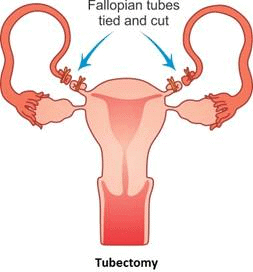
Q3: Which of the following is a hormone releasing Intra Uterine Device (IUD)?
(a) Vault
(b) Cervical cap
(c) LNG − 20
(d) Multiload 375
 View Answer
View AnswerAns: (c)
At present the most widely accepted method of contraception in India is IUDs. Intra uterine devices (IUDs) are plastic or metal objects which are inserted by doctors in the uterus through vagina. These are available as non-medicated IUDs (i.e., Lippes loop), copper releasing IUDs (CuT, Cu7, Multiload 375) and hormone releasing IUDs (progestasert, LNG-20). Vault cap is hemispheric dome like rubber or plastic cap with a thick rim which is meant for fitting over the vaginal vault over the cervix.
|
78 videos|280 docs|174 tests
|
FAQs on NEET Previous Year Questions (2014-2024): Reproductive Health - Biology Class 12
| 1. What is reproductive health and why is it important? |  |
| 2. What are the common reproductive health issues faced by individuals? |  |
| 3. How can reproductive health be promoted among adolescents? |  |
| 4. What role do healthcare providers play in reproductive health? |  |
| 5. How does reproductive health relate to overall public health? |  |





























